Related Research Articles
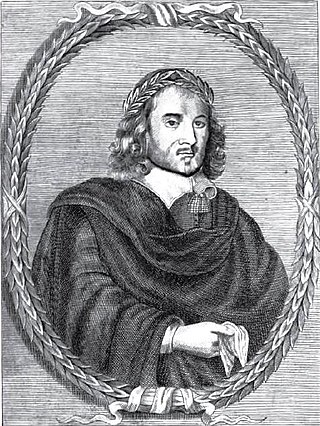
Thomas Middleton was an English Jacobean playwright and poet. He, with John Fletcher and Ben Jonson, was among the most successful and prolific of playwrights at work in the Jacobean period, and among the few to gain equal success in comedy and tragedy. He was also a prolific writer of masques and pageants.

The masque was a form of festive courtly entertainment that flourished in 16th- and early 17th-century Europe, though it was developed earlier in Italy, in forms including the intermedio. A masque involved music, dancing, singing and acting, within an elaborate stage design, in which the architectural framing and costumes might be designed by a renowned architect, to present a deferential allegory flattering to the patron. Professional actors and musicians were hired for the speaking and singing parts. Masquers who did not speak or sing were often courtiers: the English queen Anne of Denmark frequently danced with her ladies in masques between 1603 and 1611, and Henry VIII and Charles I of England performed in the masques at their courts. In the tradition of masque, Louis XIV of France danced in ballets at Versailles with music by Jean-Baptiste Lully.
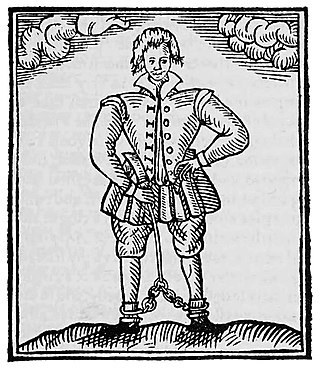
Thomas Nashe was an Elizabethan playwright, poet, satirist and a significant pamphleteer. He is known for his novel The Unfortunate Traveller, his pamphlets including Pierce Penniless, and his numerous defences of the Church of England.

John Lyly was an English writer, playwright, courtier, and parliamentarian. He was best known during his lifetime for his two books Euphues: The Anatomy of Wit (1578) and its sequel Euphues and His England (1580), but is perhaps best remembered now for his eight surviving plays, at least six of which were performed before Queen Elizabeth I. Lyly's distinctive and much imitated literary style, named after the title character of his two books, is known as euphuism. He is sometimes grouped with other professional dramatists of the 1580s and 1590s like Christopher Marlowe, Robert Greene, Thomas Nashe, George Peele, and Thomas Lodge, as one of the so-called University Wits. He has been credited by some scholars with writing the first English novel, and as being 'the father of English comedy'.

Elizabethan literature refers to bodies of work produced during the reign of Queen Elizabeth I (1558–1603), and is one of the most splendid ages of English literature. In addition to drama and the theatre, it saw a flowering of poetry, with new forms like the sonnet, the Spenserian stanza, and dramatic blank verse, as well as prose, including historical chronicles, pamphlets, and the first English novels. Major writers include William Shakespeare, Edmund Spenser, Christopher Marlowe, Richard Hooker, Ben Jonson, Philip Sidney and Thomas Kyd.
The Earl of Pembroke's Men was an Elizabethan era playing company, or troupe of actors, in English Renaissance theatre. They functioned under the patronage of Henry Herbert, 2nd Earl of Pembroke. Early and equivocal mentions of a Pembroke's company reach as far back as 1575; but the company is known for certain to have been in existence in 1592. In that year, a share in the company was valued at £80.
Like most playwrights of his period, William Shakespeare did not always write alone. A number of his surviving plays are collaborative, or were revised by others after their original composition, although the exact number is open to debate. Some of the following attributions, such as The Two Noble Kinsmen, have well-attested contemporary documentation; others, such as Titus Andronicus, are dependent on linguistic analysis by modern scholars; recent work on computer analysis of textual style has given reason to believe that parts of some of the plays ascribed to Shakespeare are actually by other writers.
Your Five Gallants is a Jacobean comedy by Thomas Middleton. It falls into the subgenre of city comedy. Allusions in the play point to a date of authorship of 1607.
Cynthia's Revels, or The Fountain of Self-Love is a late Elizabethan stage play, a satire written by Ben Jonson. The play was one element in the Poetomachia or War of the Theatres between Jonson and rival playwrights John Marston and Thomas Dekker.
Thomas Creede was a printer of the Elizabethan and Jacobean eras, rated as "one of the best of his time." Based in London, he conducted his business under the sign of the Catherine Wheel in Thames Street from 1593 to 1600, and under the sign of the Eagle and Child in the Old Exchange from 1600 to 1617. Creede is best known for printing editions of works in English Renaissance drama, especially for ten editions of six Shakespearean plays and three works in the Shakespeare Apocrypha.
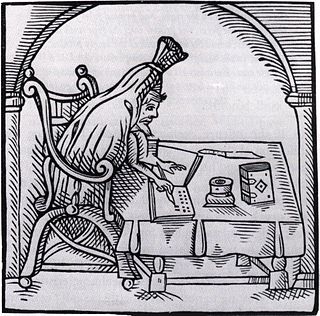
Robert Greene (1558–1592) was an English author popular in his day, and now best known for a posthumous pamphlet attributed to him, Greene's Groats-Worth of Witte, bought with a million of Repentance, widely believed to contain an attack on William Shakespeare. Greene was a popular Elizabethan dramatist and pamphleteer known for his negative critiques of his colleagues. He is said to have been born in Norwich. He attended Cambridge where he received a BA in 1580, and an M.A. in 1583 before moving to London, where he arguably became the first professional author in England. He was prolific and published in many genres including romances, plays and autobiography.
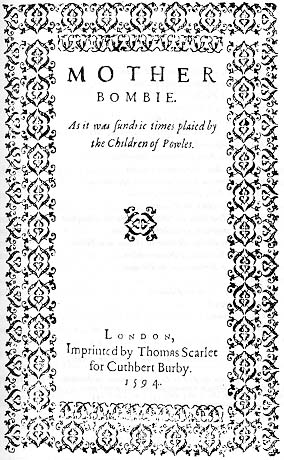
Mother Bombie is an Elizabethan era stage play, a comedy by John Lyly. It is unique in Lyly's dramatic canon as a work of farce and social realism; in Mother Bombie alone, Lyly departs from his dream world of classical allusion and courtly comedy to create a "vulgar realistic play of rustic life" in a contemporaneous England.
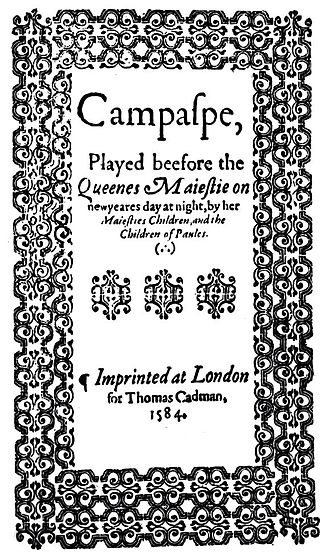
Campaspe is an Elizabethan era stage play, a prose comedy by John Lyly based on the story of the love triangle between Campaspe, a Theban captive, the artist Apelles, and Alexander the Great, who commissioned him to paint her portrait. Widely considered Lyly's earliest drama, Campaspe was an influence and a precedent for much that followed in English Renaissance drama, and was, according to F. S. Boas, "the first of the comedies with which John Lyly inaugurated the golden period of the Elizabethan theatre".
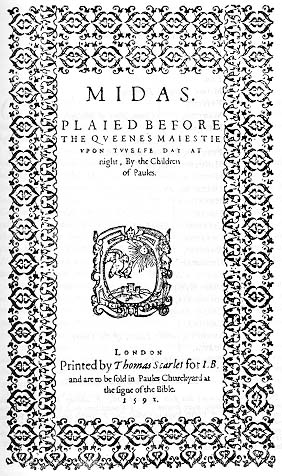
Midas is an Elizabethan era stage play, a comedy written by John Lyly. It is arguably the most overtly and extensively allegorical of Lyly's allegorical plays.
Walter Burre was a London bookseller and publisher of the Elizabethan and Jacobean eras, best remembered for publishing several key texts in English Renaissance drama.
Cuthbert Burby was a London bookseller and publisher of the Elizabethan and early Jacobean eras. He is known for publishing a series of significant volumes of English Renaissance drama, including works by William Shakespeare, Robert Greene, John Lyly, and Thomas Nashe.
George Eld was a London printer of the Jacobean era, who produced important works of English Renaissance drama and literature, including key texts by William Shakespeare, Ben Jonson, Christopher Marlowe, and Thomas Middleton.
Summer's Last Will and Testament is a choral masque or cantata by Constant Lambert, written between 1932 and 1935, and premiered in 1936. It is scored for chorus and orchestra, with a baritone solo also featured in the last of its seven movements. It is based on the play of the same name by Thomas Nashe, written around 1592. Lambert considered the work his magnum opus, and it is his largest work in any genre. However, it attracted little attention at its 1936 premiere and had only one or two other performances in Lambert's lifetime.

Pierce Penniless his Supplication to the Divell is a tall tale, or a prose satire, written by Thomas Nashe and published in London in 1592. It was among the most popular of the Elizabethan pamphlets. It was reprinted in 1593 and 1595, and in 1594 was translated into French. It is written from the point of view of Pierce, a man who has not met with good fortune, who now bitterly complains of the world's wickedness, and addresses his complaints to the devil. At times the identity of Pierce seems to conflate with Nashe's own. But Nashe also portrays Pierce as something of an arrogant and prodigal fool. The story is told in a style that is complex, witty, fulminating, extemporaneous, digressive, anecdotal, filled with wicked descriptions, and peppered with newly minted words and Latin phrases. The satire can be mocking and bitingly sharp, and at times Nashe’s style seems to relish its own obscurity.

A Knack to Know a Knave is a 1592 play closely associated with the principal performers Edward Alleyn and William Kempe. The play is a comic morality tale designed to highlight the talents of the celebrated clown Kempe, and is known from one text, itself arguably a memorial reconstruction. The author is unknown, though the involvement of Robert Greene has been suggested, as well as George Peele and Thomas Nashe. Recent scholarship has argued for a Shakespearean connection. On the basis of traditional literary-critical analysis and digital textual methods, Darren Freebury-Jones has proposed that the case for Robert Wilson's authorship of A Knack to Know a Knave is compelling. The play gives an insight into the nature of Elizabethan theatre during Shakespeare's time and the relationship between playscript and extemporised comedy.
References
- ↑ G. R. Hibbard, quoted in: Terence P. Logan and Denzell S. Smith, eds., The Predecessors of Shakespeare: A Survey and Bibliography of Recent Studies in English Renaissance Drama, Lincoln, NE, University of Nebraska Press, 1973; p. 113.
- ↑ E. K. Chambers, The Elizabethan Stage, 4 Volumes, Oxford, Clarendon Press, 1923; Vol. 3, pp. 451–3.
- ↑ Logan and Smith, pp. 112–14.
- ↑ Michael R. Best, "Nashe, Lyly, and Summers Last Will and Testament," Philological Quarterly 48 (1969), pp. 1–11.
- ↑ G. K. Hunter, ed., The Oxford History of English Literature: English Drama 1586–1642, Oxford, Oxford University Press, 1997; pp. 136–40.
- ↑ Wilfrid Howard Mellers, Between Old Worlds and New, Lewisburg, PA, Fairleigh Dickinson University Press, 1997; p. 226.
- ↑ Music Web International
- ↑ "StackPath". 14 February 2022.